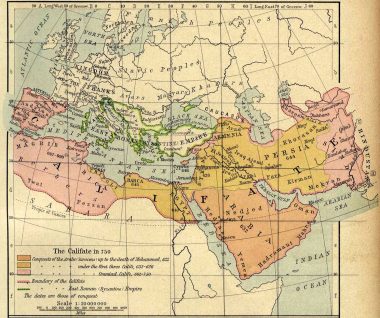The term “Moors” refers primarily to Muslim inhabitants of the Maghreb (arabian al-Maɣréb and on Berber language Tamazɣa or Tamazgh). Although Moors and Berbers are often synonym in literature, there is a small difference between them. The Berber languages were written with the ancient Libyco-Berber script known as Tifinagh opposed to Moors who spoke Arabic. The Moors were also settled down at the Iberian Peninsula, Sicily, and Malta during the Middle Ages. From the early 8th century, the Arabs conquered Spain. They remained on the Iberian Peninsula for almost 700 years. The Arab Empire united different peoples, who actually had little in common. Nevertheless, an Arab culture quickly grew and the sphere of power of Islam quickly increased. The Arabian rulers were similar to the Romans: they did not force the conquered peoples / tribes to accept their religion, language or culture, but simply taxed them. This resulted in the following years, a kind of two-class system: those who had to pay taxes and who did not have to pay. Since the middle of the seventh century, with the accession of the Umayyads, the Islamic tribes began to expand in the Arab world. They conquered the areas of today’s Afghanistan, Pakistan and the Indus area. During the reign of Abd al-Malik ibn Marwan (646-705) and Al-Walīd bin ‘Abd al-Malik (668-715) Umayyad Caliphate was at the peak of power. By the beginning of the eighth century, Egypt, Tripolitanis, Maghreb (Northwest Africa), and the entire North African coast, were also conquered by Arabians by the Umayyad Caliphate.



Already around 710 there were first attacks of Arabians on southern Spain. Only a year later, in 711, the 7.000 Muslims were build a strong base in Algeciras and they defeated the Visigoths at the Battle of Guadalete. In 712, the Islamic general Tariq Ibn Ziyad continued his triumphal procession on the Pyrenees peninsula: Toledo, Carmona, Seville and the southwest were taken. Tariq Ibn Ziyad received support of troops from another commander Musa Ibn Nusayr who led the army around 18.000 men. But between the two leaders there was disagreement. Nevertheless, the Arabs continued their conquests in the following years. In 713 Mérida was taken and one year later Zaragoza were also conquered. Because of the conflicts between the commanders, both 714 were fall back to Damascus. Musa’s son Abd al-Aziz ibn Musa ibn Nusayr was appointed for a new commander in Spain where he continued the conquest. Until 716 Abd al-Aziz managed to conquered among others territories Algrave (Portugal’s southernmost region) and Coimbra. Abd al-Aziz ibn Musa was beheaded in the monastery of Santa Rufina. Assassin was Ziyad ibn ‘Udhra al-Balawi who probably got order from Umayyad Caliph Sulayman.
In the 730s, the armies of Muslims invaded Frankish Kingdom, but they were stopped by Frankish king Charles Martel in 732 at the famous battle between Tours and Poitiers. This formed a first shock of Islamic power. In the following years, there were also internal issues of the huge Umayyad empire: A social and economic crisis led to several uprisings of the Shiites and Berbers. As a result of these uprisings, it was 750 to the demise of the Umayyad dynasty. Constantly internal issues and frequent conflicts inside the Umayyad dynasty weakened their power. The last, fourteen caliph, Merwan II. (Marwān bin Muḥammad, 744-750) was in vain trying to prevent the rule of Abbasid dynasty. In these battles between two dynasties, all members of the Umayyad Dynasty were killed except Abd al-Rahman who fled to Palestine, Sinai, Egypt and finally to Spain.
In 756 Abd al-Rahman founded the emirate in Córdoba. Later in 929, Abd-ar-Rahman III proclaimed himself caliph and from this year emirate become Caliphate of Córdoba. On the other side, since the beginning of the reign of Abbasid dynasty in Baghdad, the state has occupied a smaller territory compared to the Umayyad Caliphate. Although the Abbasid Caliphate (750-1258) were able to consolidate their power over the centuries, the empire slowly began to crumble apart. Already in the 780s Morocco detached itself and threatened from the outside. Later, from the 13th century the Mongols, invaded more frequently in the Arab Empire. At first, these events had little influence on Spain.
The Emirate of Córdoba were independent, under the rule of the Umayyads. Until the eleventh century, Spain were experienced a increasing in culture and economy. But in the early 11th century, there were throne issues, as a result, Spain disintegrated into several parts. Cordovan Caliphate ended 1031 fractured into a number of independent taifa (kingdoms). The emirate of Grenada (1238-1492) was also seceded from the Cordovan Caliphate. At the same time, Christians began the Reconquista, the slow process reconquest of Islamic lands.
